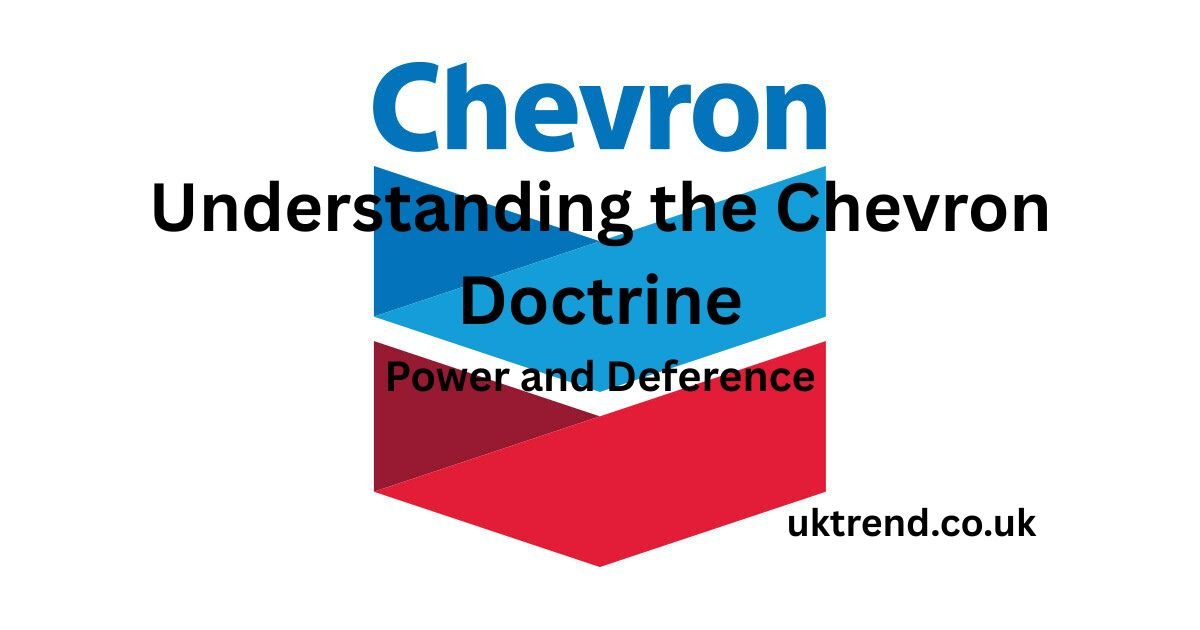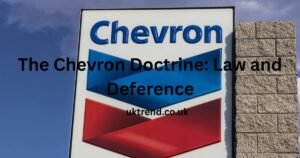Introduction
Administrative law governs the actions of government agencies, allowing them to create regulations that impact areas like health, safety, and the environment. Although it may seem distant from daily life, it directly affects things like pollution limits and food safety standards. Administrative law ensures that government agencies follow legal procedures and provides a way for citizens to challenge regulations they believe are unjust. A key concept within this field is the Chevron doctrine, established by the U.S. Supreme Court in 1984. This doctrine directs courts to defer to agencies’ interpretations of unclear or ambiguous laws, as long as the interpretation is reasonable, giving agencies leeway in their specialized areas of expertise.
Related Article: The Chevron Doctrine: Law and Deference
The Chevron Case and Its Historical Context
The Chevron case emerged as a pivotal moment in administrative law, shaping the relationship between courts and federal agencies. It arose from a dispute over the EPA’s interpretation of the Clean Air Act, highlighting the need for judicial guidance on how much deference courts should give agencies when dealing with ambiguous laws. This decision laid the foundation for the Chevron doctrine, influencing how courts evaluate agency rulemaking.
The Facts of the Case: A Deep Dive into Chevron v. NRDC
To fully understand the Chevron doctrine, we need to look at the case that created it. The case arose from a conflict between Chevron U.S.A. Inc., a major oil company, and the Natural Resources Defense Council (NRDC). The NRDC challenged the Environmental Protection Agency’s (EPA) interpretation of the Clean Air Act. The EPA had decided to allow states to set pollution standards for certain industries, which the NRDC argued was inconsistent with the intent of Congress.
In this landmark decision, the U.S. Supreme Court sided with Chevron, ruling that the EPA’s interpretation was reasonable. This decision ultimately established the framework for judicial deference to agencies when statutes are ambiguous.
The Legal Conflict at the Heart of the Case
The crux of the Chevron case was whether courts should second-guess agency interpretations of unclear laws. The Court decided that courts should not automatically substitute their own judgment for that of agencies unless the agency’s interpretation was unreasonable. This was a critical shift in how courts review administrative decisions.
What Does the Chevron Doctrine Mean?
The Chevron doctrine emphasizes that courts should defer to federal agencies when interpreting ambiguous laws, recognizing that agencies possess specialized knowledge. This deference allows agencies to make decisions in their areas of expertise, such as environmental regulation, without undue interference from the courts, unless their interpretations are unreasonable.
Judicial Deference Explained
At its core, the Chevron doctrine is about judicial deference. This means that courts should show restraint and not interfere with the decisions of federal agencies unless those decisions are plainly unreasonable. Courts understand that agencies often have more expertise in specific areas, like environmental protection or public health, and so they are better suited to interpret laws related to those areas.
For example, if an agency like the EPA interprets a law regulating air pollution, it is presumed that the agency has more technical knowledge and expertise than a court would. Therefore, the court defers to the agency’s interpretation unless it is clearly wrong.
The Doctrine’s Influence on Court Decisions
The Chevron doctrine has had a lasting impact on court decisions. It has shaped how courts handle cases involving federal agencies and their rules. This approach, however, has been controversial at times, with critics arguing that it gives too much power to unelected bureaucrats. Still, Chevron remains a cornerstone of administrative law in the U.S.
Step 1 of the Chevron Test: Is the Statute Ambiguous?
Step 1 of the Chevron test requires courts to determine whether the statute in question is ambiguous. If the law is clear and straightforward, the court will apply it directly. However, if there is uncertainty or multiple interpretations, the statute is considered ambiguous, prompting the need for judicial deference to the agency’s expertise.
How Courts Determine Congressional Intent
Chevron outlines a two-step test for courts to follow when reviewing an agency’s interpretation of a statute. The first step is to ask whether the statute is ambiguous. If a law is clear and unambiguous, the court will apply the law as written, without needing to defer to the agency. Courts will look at the text, structure, and purpose of the law to determine if it is ambiguous.
For example, if a law says that all companies must reduce their emissions, but doesn’t define what constitutes “emissions,” courts may find the statute to be ambiguous, as the term “emissions” could be interpreted in different ways.
Analyzing Examples of Ambiguous Statutes
A common example of an ambiguous statute might be a law that allows a government agency to regulate “pollution,” but doesn’t specify what types of pollutants fall under this category. In this case, courts would look at the intent of Congress and the agency’s interpretation to determine if the statute is vague enough to warrant deference.
Step 2 of the Chevron Test: Is the Agency’s Interpretation Reasonable?
Step 2 of the Chevron test involves evaluating whether the agency’s interpretation of the ambiguous statute is reasonable. Courts will assess if the interpretation aligns with the law’s purpose and intent, giving agencies significant discretion as long as their interpretation is consistent with the statute’s overall goal. If reasonable, courts typically defer to the agency’s decision.
What Makes an Agency’s Interpretation Reasonable?
Once a court determines that a statute is ambiguous, the second step of the Chevron test is to assess whether the agency’s interpretation is reasonable. In other words, the court asks whether the agency’s interpretation is within the scope of the law’s purpose and intent.
Agencies have a high level of discretion when interpreting ambiguous laws. If their interpretation is reasonable and consistent with the overall purpose of the law, courts will typically defer to the agency’s judgment.
Case Studies to Illustrate Step 2
For example, if the EPA interprets a law to include carbon dioxide as a pollutant, courts would assess whether this interpretation aligns with the broader goals of environmental protection. If the EPA’s reasoning makes sense and is grounded in scientific evidence, courts would likely find it to be reasonable.
The Effect of Chevron on Judicial Review
Chevron has shifted the judicial approach in administrative law, reducing the level of scrutiny courts apply to agency decisions. Judges now focus more on whether an agency’s interpretation is reasonable, rather than making their own judgment, allowing agencies greater flexibility in interpreting laws. This change reflects the court’s recognition of agencies’ specialized expertise.
Understanding the Role of Judges in Chevron Cases
Chevron has fundamentally changed the role of judges in administrative cases. Before Chevron, courts were more likely to engage in a detailed analysis of agency actions and make their own determinations. Now, under Chevron, courts take a step back and give agencies more room to operate when it comes to interpreting ambiguous laws.
How Courts Review Administrative Interpretations
When reviewing administrative interpretations, courts typically follow a structured process: first, they determine if the statute is clear or ambiguous, and second, they assess whether the agency’s interpretation is reasonable. If both steps are satisfied, courts will defer to the agency’s interpretation, unless it is clearly irrational.
The Strengths of Chevron: Why It’s Beneficial
The Chevron doctrine enhances efficiency by allowing agencies to make decisions using their specialized knowledge. This deference ensures that complex issues are handled by experts who have a deeper understanding of the subject matter, leading to more informed and effective regulatory outcomes.
Agency Expertise and Efficiency in Decision-Making
One of the major strengths of the Chevron doctrine is that it allows agencies to apply their expertise in specialized areas. Agencies like the EPA, FCC, and FDA are staffed with experts who understand the technical details of the regulations they enforce. By deferring to these agencies, courts ensure that decisions are made based on the most informed perspective available.
Streamlining Governmental Rulemaking
Chevron also promotes efficiency. Agencies are often better positioned to implement regulations quickly and effectively. This is particularly important in areas that evolve rapidly, such as technology or environmental issues, where new scientific research or innovations could change the regulatory landscape.
Criticisms of Chevron: Dangers of Overreliance on Agencies
Critics of the Chevron doctrine argue that it grants excessive power to unelected agencies, potentially leading to overreach. They contend that agencies might create regulations that extend beyond the scope of what Congress intended, which could result in unintended consequences or harm to individuals and businesses.
The Argument for Reducing Agency Power
While the Chevron doctrine has its strengths, it also faces significant criticism. One of the main concerns is that it gives too much power to unelected, unaccountable agencies. Critics argue that this could lead to overreach, where agencies make decisions that go beyond what Congress intended or enact policies that could harm individuals or businesses.
Examples of Overreach by Agencies
An example of overreach might be when an agency interprets a law in a way that imposes burdensome regulations on businesses or individuals without clear justification. Some argue that Chevron has allowed agencies to expand their power without sufficient oversight.
Chevron’s Role in Regulatory Policy and Public Law
Chevron plays a crucial role in shaping regulatory policy, especially in areas like environmental protection and public health. By allowing agencies to interpret laws with flexibility, it has enabled agencies such as the EPA to implement regulations that address complex, evolving issues, like climate change and pollution, in line with the latest scientific knowledge.
How Chevron Affects Regulations in Environmental and Health Sectors
Chevron has had a profound impact on sectors like environmental protection and public health. Agencies like the EPA rely heavily on the doctrine to regulate pollution, climate change, and other environmental hazards. In these sectors, Chevron has enabled agencies to take bold steps in enacting regulations that reflect the evolving understanding of risks to human health and the environment.
Case Studies of Chevron’s Influence on Major Policies
Take, for instance, the Clean Power Plan, which was influenced by the Chevron doctrine. The Obama administration’s plan to reduce carbon emissions from power plants relied heavily on the EPA’s interpretation of the Clean Air Act. This example demonstrates how Chevron allows agencies to implement sweeping policy changes based on their interpretation of ambiguous statutes.
The Political Debate: Chevron and Party Lines
Chevron has become a point of political contention, with differing views across party lines. Liberals tend to support the doctrine, appreciating its empowerment of agencies to address issues such as environmental protection, while conservatives criticize it, arguing that it grants excessive power to unelected agencies and undermines legislative authority.
How Different Political Parties View Chevron
Chevron is not just a legal doctrine; it is also a political flashpoint. Different political parties have different views on the role of agencies and judicial deference. Generally, liberals are more inclined to support Chevron because it empowers agencies to take action on issues like environmental protection and worker rights. On the other hand, conservatives often argue against Chevron, viewing it as an overreach of administrative power.
The Impact of Political Preferences on Chevron’s Application
Political shifts can have a significant impact on how Chevron is applied. Changes in administration can lead to shifts in agency priorities, and with it, new interpretations of existing laws. This is why Chevron is often discussed in political circles—because its application can change the direction of federal regulations.
The Future of Chevron: Will It Be Overturned or Reformed?
The future of Chevron remains in flux, with increasing discussions about its potential reform or overturn. Some members of the Supreme Court have expressed concerns over the doctrine, questioning whether it unduly shifts power to administrative agencies at the expense of judicial oversight and the democratic process.
Current Legal Trends Surrounding Chevron
The future of Chevron is uncertain. There has been ongoing debate about whether the doctrine should be reformed or overturned. Some Supreme Court justices have called for rethinking Chevron, and there are growing concerns about the balance of power between the judiciary and administrative agencies.
Possible Alternatives to the Chevron Doctrine
If Chevron were overturned, courts might return to a more active role in reviewing agency interpretations. Alternatively, there could be reforms that strike a balance between judicial review and agency deference, ensuring that agencies do not overstep their authority while still being allowed to regulate effectively.
Final Thoughts
Chevron remains one of the most important doctrines in administrative law. It has helped shape how courts interact with administrative agencies and has influenced regulatory policies across various sectors. While it is not without its criticisms, the doctrine’s emphasis on agency expertise and efficiency has played a crucial role in streamlining government rulemaking.
As we look to the future, Chevron’s role in administrative law will continue to be a subject of debate. Whether it will be reformed, replaced, or reaffirmed, one thing is certain: the Chevron doctrine will remain a key part of how laws are interpreted and applied in the United States.
FAQs:
Q. What is the Chevron doctrine?
The Chevron doctrine is a principle in administrative law that mandates courts defer to agencies’ interpretations of ambiguous statutes, as long as the interpretation is reasonable.
Q. How does Chevron impact judicial review?
Chevron impacts judicial review by limiting the scope of courts’ involvement in reviewing agency decisions. Courts defer to agencies’ interpretations unless they are unreasonable.
Q. What are the two steps in the Chevron test?
The two steps are: 1) Is the statute ambiguous? 2) Is the agency’s interpretation reasonable?
Q. Why do critics oppose Chevron?
Critics argue that Chevron gives too much power to unelected agencies, allowing them to make decisions that may not align with Congressional intent.
Q. Will Chevron be overturned?
It is uncertain. There has been ongoing debate about whether the doctrine will be reformed or replaced, especially as political and legal trends evolve.








